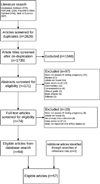Suicidal ideation in pregnancy: an epidemiologic review
- PMID: 27324912
- PMCID: PMC5023474
- DOI: 10.1007/s00737-016-0646-0
Suicidal ideation in pregnancy: an epidemiologic review
Abstract
Suicidal behaviors are the leading causes of injury and death worldwide, and are leading causes of maternal deaths in some countries. One of the strongest risk factors, suicidal ideation, is considered a harbinger and distal predictor of later suicide attempt and completion, and also presents an opportunity for interventions prior to physical self-harm. The purpose of this systematic epidemiologic review is to synthesize available research on antepartum suicidal ideation. Original publications were identified through searches of the electronic databases using the search terms pregnancy, pregnant women, suicidal ideation, and pregnan* and suicid* as root searches. We also reviewed references of published articles. We identified a total of 2626 articles through the electronic database search. After irrelevant and redundant articles were excluded, 57 articles were selected. The selected articles were original articles that focused on pregnancy and suicidal ideation. Of the 57 included articles, 20 reported prevalence, 26 reported risk factors, 21 reported consequences of antepartum suicidal ideation, and 5 reported on screening measures. Available evidence indicates that pregnant women are more likely than the general population to endorse suicidal ideation. Additionally, a number of risk factors for antepartum suicidal ideation were identified including intimate partner violence, <12-year education, and major depressive disorder. There is a need for enhanced screening for antepartum suicidal ideation. The few screening instruments that exist are limited as they were primarily developed to measure antepartum and postpartum depression. Given a substantial proportion of women with suicidal ideation that does not meet clinical thresholds of depression and given the stress-diathesis model that shows susceptibility to suicidal behavior independent of depressive disorders, innovative approaches to improve screening and detection of antepartum suicidal ideation are urgently needed.
Keywords: Antepartum; Pregnancy; Suicidal ideation; Suicide.
Conflict of interest statement
Conflicts of Interest: None declared
Figures
References
Publication types
MeSH terms
Grants and funding
LinkOut - more resources
Full Text Sources
Other Literature Sources
Medical



